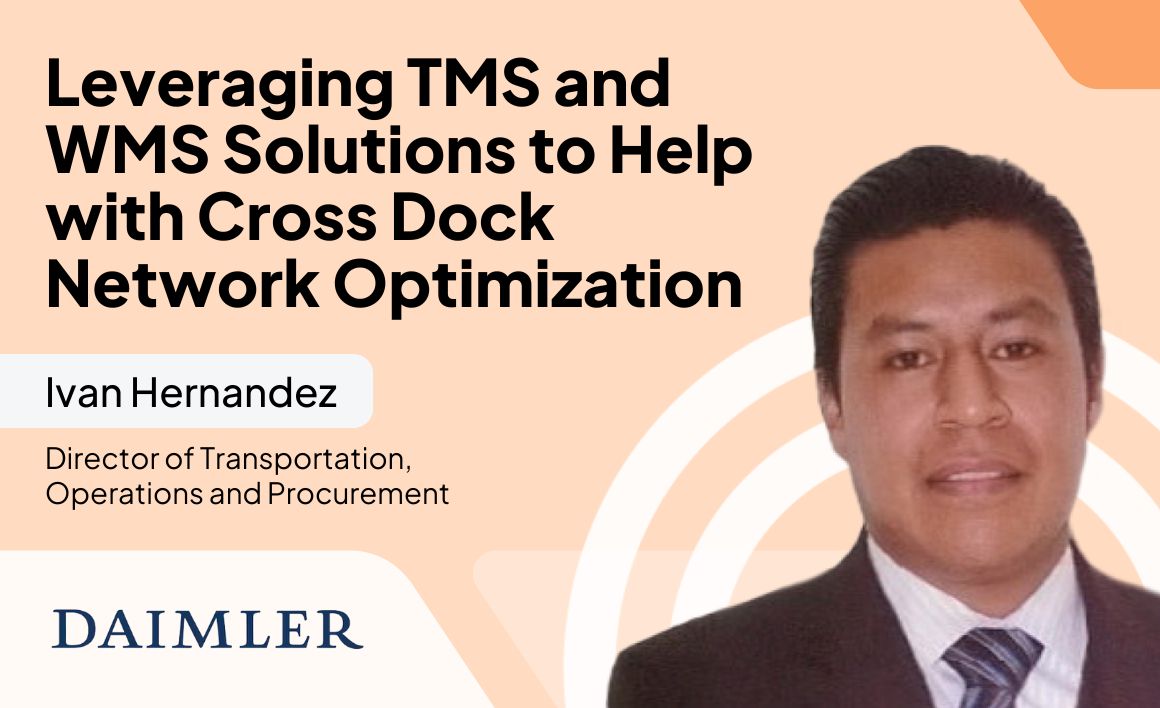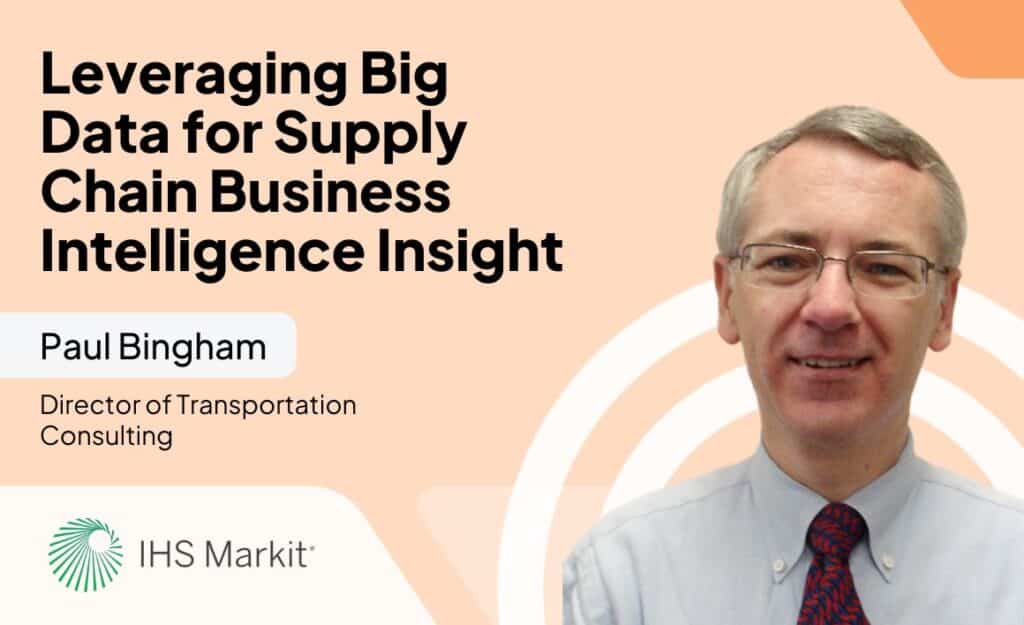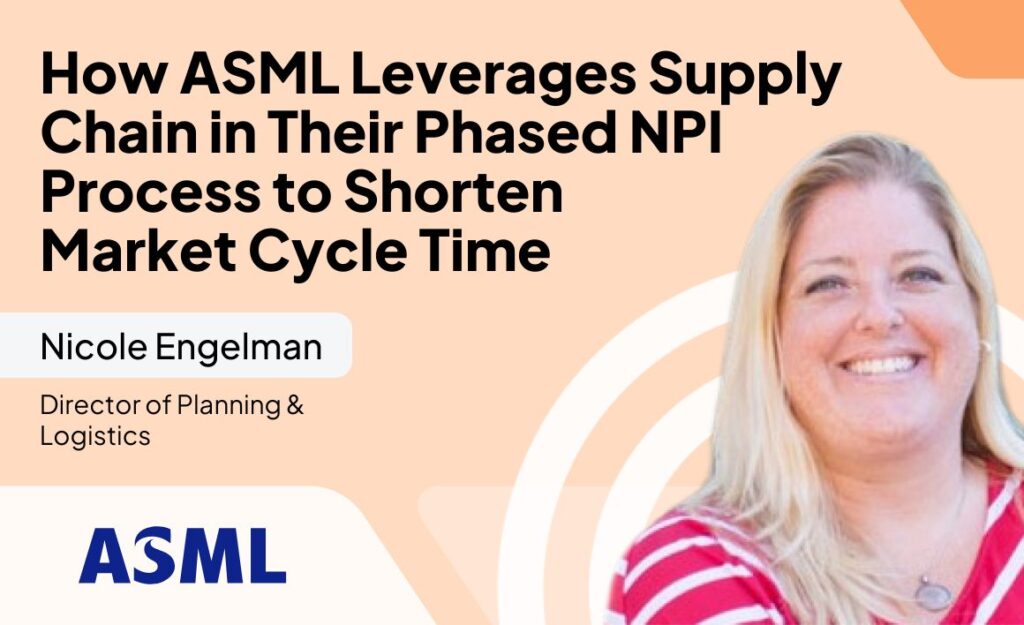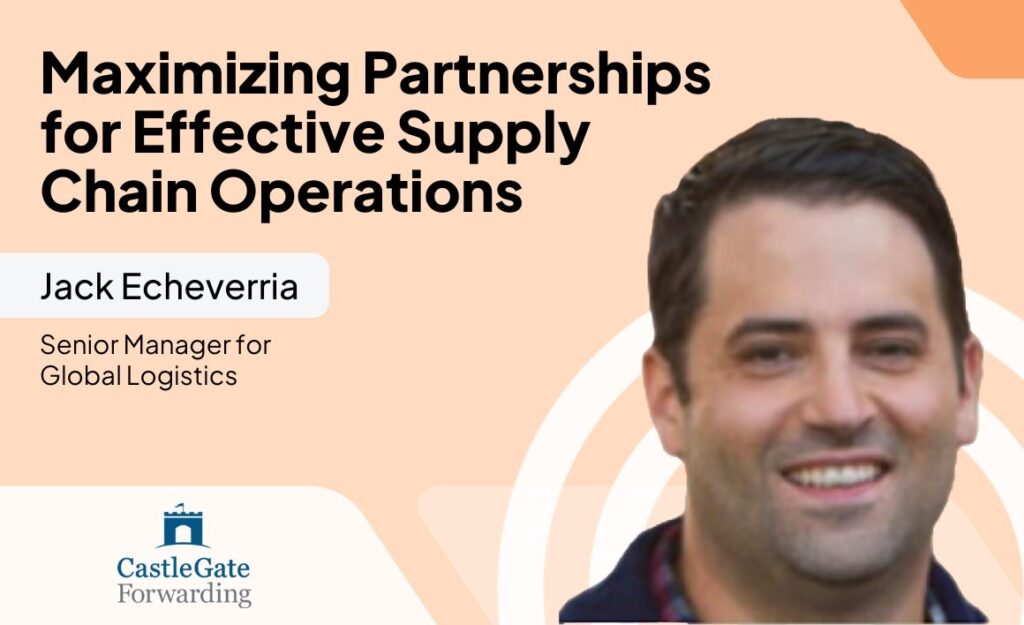
Leveraging TMS and WMS Solutions to Help with Cross Dock Network Optimization with Ivan Hernandez
Ivan Hernandez
17:31
“Major consideration, as I mentioned, is customer service. In this case, our plants. Second, we are a truck manufacturer. It was very important that through this process, we could keep the relationship with the carriers very close to Daimler. We didn’t want to hand this over to a logistic provider. We want to keep this very close to us in a sense, the carriers that move our freight are also our customers. That’s why it was very important for us to keep that.
Another important element was to give them the strategic consideration of the location of those cross docks. We wanted to make sure that in this particular case in Mexico, we could keep control of the facility. So that as time goes on, we have that control so that we can choose based on the performance of the provider that should be running that facility. That was also one of the main topics.”
– Ivan Hernandez, Director of Transportation Operations, Daimler Trucks North America
Full Transcript
Francis Adanza
Welcome to the down to freight podcast where we sit down with transportation, logistics, and supply chain subject matter experts to discuss digital transformation projects. I’m the host of the show, Francis Adanza, and it’s a pleasure to welcome Ivan Hernandez, Director of Transportation, Operations and Procurement for Daimler Trucks North America.
Ivan, it’s great to have you. Can you please tell the listeners a little bit about yourself, your company, and what you’re responsible for at Daimler?
Ivan Hernandez
Hi, Francis. Thank you very much for having me here. Yeah. So I’m Ivan Hernandez. I’m the Director of Transportation, Procurement and Operations at Daimler Trucks North America.
I’m responsible for two main areas in our company. One is Transportation Procurement. That function is done across all the Daimler entities in North America. What that means is that I procure transportation, not only for the truck division but also for the passenger car division, which is best known as Mercedes-Benz.
And we procure all types of transportation, right? So finished vehicle transportation from our factories to the dealers, inbound transportation of parts to our factories, as well as parts from suppliers to PDCs and from PDCs to dealers and we cover all the modes of transportation.
And then the second main area of activity is on the transportation operations side of the truck business. Yeah. So in other words my team is responsible for bringing all the parts required to build our trucks to our factories that we have across North America. We have two factories in Mexico and we have three factories in North America. And then we support that with parts plants that we have in Mexico and in the United States. And that’s basically my responsibility. It’s very challenging and very exciting.
Francis Adanza
Great. Thank you for providing that overview. That provides a lot of context. So as you know, we’re here to talk about technology. Is there a recent project or current project that you’re working on that you’d like to share?
Ivan Hernandez
Yeah, so I think lately last year, prior to COVID, we engaged in the first phase of our cross-dock network optimization. And we took the focus on phase one to be in Mexico. And the whole project is — to explain it very simply, was looking at the network of suppliers that fall into that cross dock network and try to determine what is the best position, geolocation that is called for those cross docks, and then try to find a physical relocation that could be close to that optimal.
And then do all the optimization for the routes. So that’s the latest project that we worked on.
Francis Adanza
Got it. So this sounds like an interesting mix of process changes as well as solution implementation. Ultimately, what was the problem that you were trying to solve when you were piecing all of this together?
Ivan Hernandez
We are a company, right, that is driven by profits and making money. So the main objective that we always have is, number one, how can we better service our factories; and number two, how can we do that at the lowest cost possible? And that was the main objective, right?
So we had a network that had been in operation already for many years, before my time even, and we wanted to optimize. We wanted to try to eliminate as much of the middle man type of transactions that existed in that network. And that was our primary objective.
Francis Adanza
Thank you. So as you thought about this problem or the primary objective, what were some of the major considerations?
Ivan Hernandez
Yeah. Good question, Francis. Major consideration, as I mentioned, customer service, in this case, our plants. Second is we are a truck manufacturer, right? So it was very important that through this process, we could keep the relationship with the carriers very close to Daimler. We didn’t want to hand this over to a logistic provider. We want to keep this very close to us in a sense, the carriers that move our freight are also our customers.
So that’s why it was very important for us to keep that. Another important element was to give him the strategic consideration of the location of those cross docks, we wanted to make sure that in this particular case in Mexico, that we could keep control of the facility.
So that as time goes on, we have that control so that we can choose based on performance the provider that should be running that facility. So that was also one of the main topics.
Francis Adanza
Great, thank you. That makes a lot of sense. It seems like you could come to these conclusions without technology. What role did those three systems play in this project?
Ivan Hernandez
Yeah. Let me tell you a little bit about my philosophy, right? Because I think it’s important to understand the role of technology in every project. At Daimler, we are a company that tries to incorporate a lot of the lean principles that we have learned from Toyota over the years. And one of those principles is the principle of reflection, and being able to complete your plan-do-check-act cycle. So being able to reflect on what was the performance of that network, being able to understand what were the elements that we wanted improvement on was very key. So I think that is important.
And it’s an element that you mentioned where you don’t need technology, right? You just need to have the discipline to carve out time to go to that reflection and really confront yourself to the real performance of your network and really identify where the opportunities are, right?
Once you have determined that now, because that is absolutely critical, right? So if you apply technology, and you don’t have an absolutely clear reason what you want,. you run the risk that you will either automate a mess, right? Or you will end up in a bad situation. So it is absolutely clear that you spend time in that reflection.
So once you have clear that then we currently have technology that we didn’t have available years ago. And to be able to come to conclusions for this type of network where you have a lot of data. You have shipment data on a daily basis, many times during the day you have weights, you have dimensions, et cetera, et cetera, et cetera.
That is where technology comes into place. Number one, the technology allows you to analyze huge amounts of data in a very efficient way that we didn’t have years back. Benefit number one. Benefit number two is that software has the computing capacity has increased. So now running simulation is much more effective than it was in the past. And for this specific project, one of the main elements was to define the optimal location for the cross docs. And that technology becomes important. We use our third pilot USAC provider capabilities to do that for us.
So we basically gave them the data about our shipments that we experienced in a period of time, which is a lot of data. And then with that information, they were able to find the most optimal location that minimizes the amount of miles that are driven on a daily basis. So if you minimize miles, that means your cost is going to be lower.
It means the impact that you are going to have on the environment is going to be lower. Less miles, less gas, so there . And that was the key. So to try to use the technology for that, right? It allows to tweak number one, when you do that for the first time, you get an Optima.
And we know. Many answers that our software give you on where a location is in real life may not be possible, right? Why? Because the software is using algorithms that will give you the coordinates of where you are going to minimize transportation costs. But in real life, you may not be able to find the warehouse that has the requirements that you need to be able to perform across local operation.
So, that is where you need to start blending that technology now with real life. in doing tweaking, do some tweaking for your final solutions.
Francis Adanza
Got it. Then, can you please tell us a little bit about the challenges of matching the software result to the real life availability of this space?
Ivan Hernandez
Of course Francis. And that is basically where the software becomes very useful, right? Because you have to do different iterations to see what are the total landed cost of your solutions is as you provide different inputs of the available locations. So what happens is somewhere, the first iteration of the software may give you a result that the best location is located in the middle of a lake, for example, or in the middle of a residential area.
So when you look at that and see, oh, sorry, I hear in this area, we don’t have the building or the possibility to build a building with the characteristics that are required to run across them. So at that moment you need to start just basically creating areas right. That is somehow close to that optimal start serving available spacehat means your characteristics. And as you do that, then it’s important that you rely on that software to rerun your scenario. So now the first thing is a get, where would be the optimal, and then based on the real-life availability of space, you start now running each scenario, right?
So let’s say, we found a warehouse that was ten kilometers meters away from our optimal,north of where the optimal was. And then we found another one that was five kilometers south of that optimal. So we now run those scenarios and compare them against each other to determine what the best option is.
And that is the beauty of having a software or a model that you can quickly change the input parameters and that it could tell you exactly, “Hey, this is the result of the cost”, right? And that way you can now be very dynamic on running those sensitivity analysis that will allow you to make decisions.
Francis Adanza
Got it, that makes a lot of sense. So how many different scenarios or models do you need to run before you can come to a decision? And typically how long did it take to perform these analyses before you finally made a decision?
Ivan Hernandez
Yeah, and I don’t think there is a silver bullet, or a formula that tells you, “Hey, you need to at least do 10 or 100.”
I think it will depend on management discretion. It will depend on the knowledge that you have of the area. It will depend on how many sites you have available. That is where that real human interaction is important. And it’s also as, every project will have a different timeline, and for every project there are different outside constraints and pressure that you need to weigh in.
So I think there is no real bullet point, at least. I would say that as a minimal, you need to have an optimal that will serve as our reference point. And then you need to have at least a handful of options. That would be my bet.
So I think the more, the merrier. But I can tell you, with these types of facilities, where it’s very difficult to find, right? Because you’re talking about constraints in terms of this size, you’re talking about how many doors they have. You are talking about whether the facility has a trailer guard or not — all these things that come into play. So it will depend on each project.
Francis Adanza
Got it. So now that you’re on the other side of this project, are you realizing all of the anticipated ROI that you projected?
Ivan Hernandez
From the optimal perspective, yes. So I think the operation has improved dramatically. We were able to save a significant amount of dollars with the lease of the facility.
And now we can optimize the transportation. Since we have finished the project there, obviously there have been other headwinds coming our way. Like now, we are all familiar with the challenges that we have on hiring drivers. Nowadays, you have to pay more for that.
Some of our cost elements have gone up, right. For reasons that we didn’t, that we didn’t consider it. But we didn’t know what was going to be the magnitude of the increases. But definitely the project was a success. And as a result, we were enjoying better operations and definitely a better cost position.
Francis Adanza
Oh, that’s awesome. This was a fantastic story. What’s next for you or for Daimler Trucks?
Ivan Hernandez
Yeah, so I think there are many challenges, right? So I think in terms of what’s happening right now with the country, we are enjoying a very good market where we are increasing our production to levels that we have never seen before.
So that is putting a lot of big challenges to myself and my team, to support those ramp up. But in terms of the topic that we were discussing in terms of technology, we have different projects in our pipeline. We will continue optimizing our cross dock network now in the United States.
So we will be using some of those tools again to do some assessments. We are trying to create a model help us do financial OP planning for our network. And as I mentioned, we are ramping up production. So we want to have a model that very quickly tell us what would be our costs if we produce X amount of trucks in Mexico or X amount of trucks in the United States,and what happened if we change the mix? We have such a model, right? It’s being developed and fine tuned, but really our vision would be to have a very dynamic model that really mirrors real life, that we can have all the different elements.
That would be our ultimate goal for that.
Francis Adanza
Amazing. And it was great meeting and speaking with you today. Thank you for sharing this story. I’m sure the listeners are going to get a lot from it.
Ivan Hernandez:
Thank you, Francis. And it was a pleasure being here with you.
Continue listening
Ready to transform your supply chain?
Increase efficiency and productivity. Say goodbye to delays, handwriting errors, and time-intensive manual data entry.




